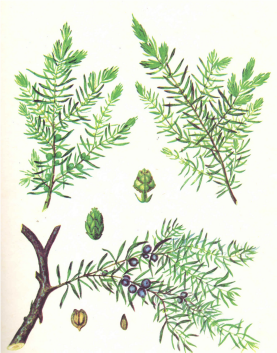Family Cupressaceae
The cypress and thuja subfamilies have scale-like leaves and woody cones; they are decorative cultivated trees and shrubs. The juniper subfamily includes wild species.
The juniper subfamily is represented locally by a single genus, Juniperus (juniper). It differs from other subfamilies by having juicy berry-like cones. These are shrubs or, less commonly, small trees. Leaves are of two types: in species of the subgenus Oxycedrus, they are short, sharp needles arranged in whorls of three; in the subgenus Sabina, the leaves are scale-like, cross-paired, and partly fused to the branches. Heterophylly is observed, meaning both types of leaves may occur on the same shrub, depending on light or shrub age. Resin canals are absent in the wood; resin occurs in individual cells. Essential oil is stored in reservoirs in the leaves, with one canal per needle, one rounded reservoir per scale’s back, and several rounded reservoirs in the berry-cones.
Essential oils are dominated by pinene, typical of conifers. Some Sabina species contain the sesquiterpene alcohol cedrol, absent in the Oxycedrus subgenus.
The juniper is an evergreen shrub with spiny needles in whorls of three. Male and female cones grow on separate plants. Female cones consist of several whorls with three scales each, but only the upper whorl forms three fertile seed scales, each with one ovule. After fertilization, the upper seed scales swell, become fleshy, and fuse to form a juicy berry-like cone, or galbulus; the suture is visible as three tiny whorls. Galbulus are initially green, darkening to almost black upon maturity. They mature slowly, taking two years, so green and black berries may occur simultaneously. Ripe black berries are sweet, aromatic, and contain three hard seeds.

It grows in the understory of coniferous and mixed forests, often forming thickets in areas where forests have been cleared. It adapts widely to various soil types and moisture levels. Its range includes northern and central Europe, Western and parts of Eastern Siberia. It is absent in the Far East, Central Asia, and the Caucasus.
Juniper berries, Fructus Juniperi, are harvested in autumn. The shrub’s spiny nature complicates handpicking, so a mat or cloth is placed under the bush, and branches are gently struck with a stick to dislodge ripe berries. After harvesting, the berries are sorted to remove needles, twigs, and unripe fruits and are air-dried.
Berry cones contain 0.5–2% essential oil (composed of pinene, sesquiterpene cadinene, terpinolene, etc.), invert sugar (13–40%), resin (9%), pectins (pentosans), organic acids, and more.
Juniper needles also contain essential oil.
The red juniper (Juniperus oxycedrus L.), a large shrub, has needles and spherical reddish-brown berry-cones. It grows in the Crimean and Western Caucasus mountains. Its wood is dry-distilled to produce tar (Oleum Cadinum) with disinfectant properties, used for skin diseases.
Subgenus Sabina
Tree-like junipers, such as the hemispherical juniper (Juniperus semiglobosa Rgl.), Turkestan juniper (Juniperus turkestanica Kot.), and Zeravshan juniper (J. zeravshanica Kot.), form sparse forests on dry mountain slopes in Tajikistan, Uzbekistan, and Turkmenistan. Branches have appressed scale-like leaves, with sharp needle-like leaves on shaded lower branches. Berry cones are black, aromatic, and not sweet.
Steam distillation of these junipers’ branches yields essential oil with pinene (~75%), sesquiterp.
